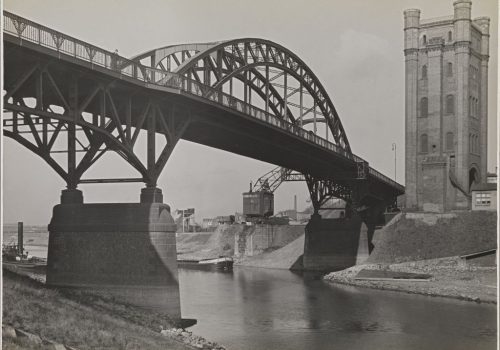As FOTO/INDUSTRIA in Bologna is quite an articulated event there’s not just one path to vision it. Alongside the “classical” ones which takes us through the photographers’ work according, for instance, to a particular time sequence or marked by the locations, all evocative ones. Like Santa Maria della Vita, with its frescoed ceilings, the Biblioteca Universitaria di Bologna, with its suggestive atmoshere or the modern spaces of the MAST. One may also opt to visit the 4th Biennial of Photography on Industry and Work exploring curved lines and finding them even in the work of authors more related to rationalist or minimalist aesthetic. Indeed the universal allure of the circle fascinates many artists. For instance, Vassilij Kandinskij used to say: “Cold tension of the straight lines, warm tension of the curved lines” (Point and Line to Plane, 1926, Bauhaus Books). And curved shapes evoke calmness, peacefulness and safety.
In this respect curves may appear in contrast with the issues of work, industry or technosphere, but, as Urs Stahel, curator ot the Anthropocene exhibition at MAST, explains “Since the beginning the circle is linked to the idea of work and dynamism. Besides the wheel, we may refer to gears and cogs, to name a few”. Briefly, the curvilinear shapes are comforting, but they suggest energy and power, too.
Among the on stage photos by André Kertész, curved lines are well represented, especially while documenting the Firestone plant (tyres are “motion” par excellence). One of his images emblematic for its composition seems to refer to the Vitruvian Man. Some shapes remind a vortex focusing on the main subjects, like in the images by Lisetta Carmi, whose “direct knowledge of work-related themes prompted her to photograph some of the most spectacular and dangerous production processes, such as the casting of steel at Italsider (…) or the most electromechanically advanced products manufactured by ASGEN”, curator Giovanni Battista Martini says.
A sense of vortex also characterizes Spectral City by Stephanie Syjuco. It “evokes A Trip Down Market Street shot in 1906 by the Miles Brothers. The silent film was a recording of the route taken by a cable car through the center of San Francisco: it was shot four days before the earthquake. Spectral City replicates this very itinerary, but Syjuco reconstructed it with Google Earth software: the result is a second cataclysm. The computer tries to imitate our vision and the result is a dystopic world, fascinating and desolate”, curator Francesco Zanot says. Curved shapes, ranging from the wheel of a Ferrari to cogs and gears, are also within the images by Luigi Ghirri. Precise and accurate, his photos were not a pure celebration of the product as they are always marked by a measured tone and a sense of normality. The series by Délio Jasse are based on the superimposition of two transparencies, creating a third surreal though plausible representation. It is an impossible world, consisting of buildings that collapse onto each other, while the reference is to the uncontrolled growth of Luanda. Even Yosuke Bandai in his project A Certain Collector B uses curves (also recalled in the setting up). “He collected a series of objects lying in the street (fragments of plastic or wood, even rubbish) as the elements for minimal sculptures, minimal indicators of the human need to build. He scanned them and presented them as photographic prints, so eluding the flow of time”, Zanot explains.
There’s no shortage of circles and spirals in Prospecting Oceans by Armin Linke or at MAST, where the signs of the machines in the Uralkali Potash Mine in Russia or a Spanish Solar Plant map photographed by Edward Burtynsky are part of Anthropocene, an art project investigating the indelible human footprint on the Earth through the images by Burtynsky, Jennifer Baichwal and Nicholas de Pencier.
According to curator Simone Förster, the exhibition by Albert Renger-Patzsch in Bologna is quite a surprise, “as he is considered one of the most important photographers of New Objectivity”. Instead, the photos on show are landscapes. “They are the largest coherent group of works in Renger- Patzsch’s œuvre, photographed independently of any commission”. They are populated by streets, railways, bridges and miners’ houses. Through their linearity (but also their curves), paths become a graphic structure, connecting the foreground and background”. Matthieu Gafsou deals with transhumanism and unfolds the mystery of these technical and scientific advances that are disrupting social ties. His photographs’ frozen look induces an unease that is occasionally intensified by the captions that accompany them. And is always Kandinskij who assumed curved shapes as time indicators. It’s a concept David Claerbout took up in his project Olympia, a computer-generated replica of the Olympic stadium in Berlin, which finds itself in a time-space devoid of human intervention and entrusted to the cycles of nature, from creation to dissolution.
Paola Sammartano
Paola Sammartano is a journalist, specialized in arts and photography, based in Milan
FOTO/INDUSTRIA 2019
IV BIENNIAL OF PHOTOGRAPHY ON INDUSTRY AND WORK
Tecnosfera/ Technosphere: Humankind and the Built Environment
From October 24 to November 24, 2019
Biblioteca Universitaria di Bologna – Armin Linke – Prospecting Ocean; Fondazione Cassa di Risparmio in Bologna – Casa Saraceni – André Kertész – Tires / Viscose; Fondazione del Monte di Bologna e di Ravenna, Palazzo Paltroni – Délio Jasse – Arquivo Urbano; Genus Bononiae, Santa Maria della Vita – Lisetta Carmi – Porto di Genova; Mambo, Museo d’Arte Moderna di Bologna – Stephanie Syjuco – Spectral City; MAST. – Anthropocene – Edward Burtynsky, Jennifer Baichwal, Nicholas De Pencier (open until January 05, 2020); Museo Internazionale e Biblioteca della Musica – Yosuke Bandai – A Certain Collector B; Palazzo Bentivoglio – Luigi Ghirri – Prospettive industriali; Pinacoteca Nazionale di Bologna, Palazzo Pepoli Campogrande – Matthieu Gafsou – H+; Pinacoteca Nazionale di Bologna, Palazzo Sant’ignazio – Albert Renger-Patzsch – Paesaggi della Ruhr; Spazio Carbonesi – David Claerbout – Olympia
Bologna
















